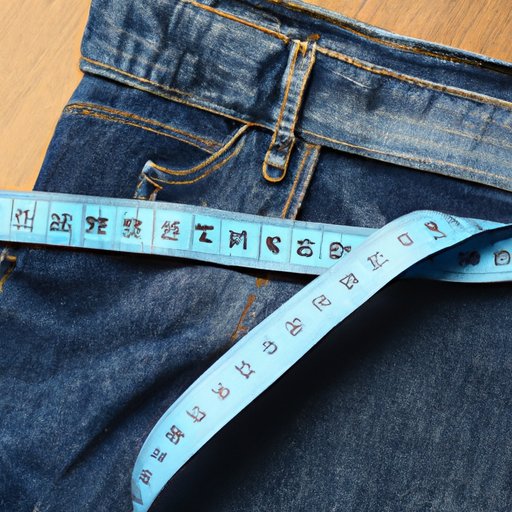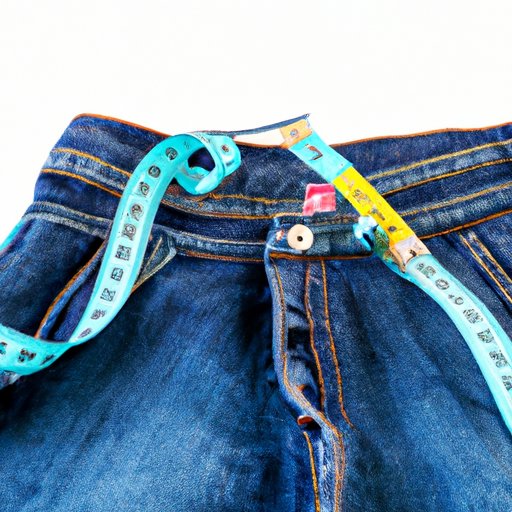
I. Introduction
Measuring jeans can be a daunting task, but getting the perfect fit is worth the effort. Ill-fitting jeans can cause discomfort, restrict movement, and even impact self-confidence. Common problems encountered when measuring jeans include incorrect measurements, not factoring in body shape, and not understanding how different fabrics can affect the fit. With the right tools and knowledge, however, measuring jeans doesn’t have to be complicated.
II. 7 Simple Steps to Measure Your Perfect Pair of Jeans
Before beginning, make sure you have a tape measure, a flat surface, and a friend to assist you if necessary.
Step 1: Gather necessary tools
Make sure you have a fabric tape measure, a flat surface to work on, and a friend to assist you if needed.
Step 2: Identify key measurement points
Locate your waist, hips, seat, rise, and inseam. Take note of where each point falls on your body.
Step 3: Measure waist
Wrap the measuring tape around your natural waistline, typically one inch above your belly button. Make sure the tape is straight and not too tight or too loose.
Step 4: Measure hips and seat
To find your hip measurement, place the measuring tape around the fullest part of your hips, usually about seven to nine inches below your waistline. To get your seat measurement, measure from one hip to the other across the widest part of your backside.
Step 5: Measure rise
The rise is the distance from your waistband to the crotch seam at the front of your jeans. To measure, hold the measuring tape at your natural waistline and bring it down to the crotch seam at the front of your jeans.
Step 6: Measure inseam
The inseam is the distance from the crotch seam to the hem of your jeans. Measure from the inside leg at the crotch to the bottom of the hem.
Step 7: Compare measurements to size chart
Compare your measurements to a size chart to determine your correct size. Keep in mind that different brands may have slightly different fits, so it’s essential to check each brand’s size chart individually.
III. The Foolproof Guide to Measuring Your Jeans Like a Pro
While the above steps are straightforward, it’s essential to take a few extra measures to ensure accurate measurements.
First, wear thin clothing or no clothing at all when taking your measurements. Bulkier clothing can skew the numbers and cause a less-than-perfect fit.
Second, stand up straight and don’t suck in your stomach. This posture is the most accurate representation of your body shape and will result in a more accurate measurement.
If you have an irregular body shape, such as a prominent stomach or large hips, you may need to adjust your measurements. In general, it’s best to size up if you’re between two sizes or have wider hips and a smaller waist.
IV. Everything You Need to Know About Measuring Your Jeans: Tips and Tricks
As mentioned, measuring jeans can be tricky, so here are a few tips to help you avoid common mistakes and handle different denim fabrics and styles.
If you’re measuring jeans that have already been worn or stretched, it’s best to measure them as they lie flat. This technique will give you a more accurate measurement and a reliable indication of how the fabric will fit over time.
When measuring for different denim styles, keep in mind that high-waisted jeans will require a measurement for the natural waistline, while skinny jeans will need a tighter hip measurement. Additionally, different fabrics, such as stretch denim, may require a different size than traditional denim.
V. Sizing Up Your Denim: How to Measure Jeans the Right Way
Measuring jeans for men and children follows a similar process to measuring women’s jeans. Men generally have a lower waistline and more relaxed fit, while children will need measurements adjusted for age and height.
When it comes to measuring for particular styles like mom jeans or flare jeans, take note of the style’s fit parameters and adjust accordingly. While the measurements may vary slightly, the essential measurement points are still the same.

VI. The Essential Guide to Measuring Jeans for a Flattering Fit
No matter your body type, there’s a perfect jean fit for you. When measuring for the best fit, keep in mind that straight-leg jeans are a classic choice for all body types, while bootcut and flare jeans are perfect for highlighting an hourglass figure. In contrast, high-waisted jeans are ideal for creating a curvier silhouette.
To adjust your measurements for a custom fit, consider taking them to a tailor or purchasing jeans with adjustable sizing like those with an elastic waistband.
VII. Get the Most Accurate Measurements: Expert Advice on Measuring Your Jeans
To get the most accurate measurements possible, we spoke with a denim expert, Jean M. Back, founder of the Jean Queen denim brand.
“The most important thing is to ensure you measure each point as accurately as possible,” says Back. “Don’t rush and take a few extra moments to ensure your measurements are precise.”
Back also recommends measuring your favorite pair of jeans and comparing them to size charts for new brands. “Think of your favorite pair of jeans as a reference point for future purchases. If you’re unsure, always size up, as it’s much easier to take fabric away than to add it.”
VIII. Measuring Up: A Step-by-Step Guide to Finding Your Ideal Jean Size
To recap, finding the perfect pair of jeans requires accurate measurements using a fabric tape measure and a friend for assistance. Remember to wear thin clothing or no clothing at all, stand up straight, and adjust your measurements as needed for different fabrics and styles.
When in doubt, always check the size chart of each brand, and consider sizing up if you have a more irregular body shape.
IX. Conclusion
In conclusion, measuring your jeans can seem intimidating, but it’s essential for getting the perfect fit. Following these steps and tips will help ensure an accurate measurement that leads to a comfortable and flattering pair of jeans.
Remember that sizing may differ between brands and styles, so don’t be afraid to experiment with different sizes until you find what works best for you. With a little patience and practice, you’ll be measuring your jeans like a pro in no time.





